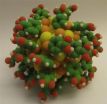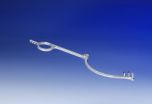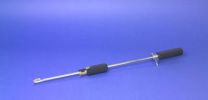(Press-News.org) UPTON, NY - A brain imaging study at the U.S. Department of Energy's (DOE) Brookhaven National Laboratory reveals a subtle difference between ordinary obese subjects and those who compulsively overeat, or binge: In binge eaters but not ordinary obese subjects, the mere sight or smell of favorite foods triggers a spike in dopamine - a brain chemical linked to reward and motivation. The findings - published online on February 24, 2011, in the journal Obesity - suggest that this dopamine spike may play a role in triggering compulsive overeating.
"These results identify dopamine neurotransmission, which primes the brain to seek reward, as being of relevance to the neurobiology of binge eating disorder," said study lead author Gene-Jack Wang, a physician at Brookhaven Lab and the Mount Sinai School of Medicine. Previous studies conducted by Wang's team have identified a similar dopamine spike in drug-addicted individuals when they were shown images of people taking drugs, as well as other neurochemical similarities between drug addiction and obesity, including a role for dopamine in triggering desire for drugs and/or food.
"In earlier studies of normal-weight healthy people who had been food-deprived for 16 hours, we found that dopamine releases were significantly correlated with self-reports of hunger and desire for food. These results provided evidence of a conditioned-cue response to food," Wang said.
In the current study, the researchers suspected that binge-eating obese subjects would show stronger conditioned responses to food stimuli when compared with non-binging obese subjects.
"Understanding the neurobiological mechanisms underlying food stimulation might point us toward new ways to help individuals regulate their abnormal eating behaviors," Wang said.
The scientists studied 10 obese people with a clinical diagnosis of binge eating disorder, based on evaluations at St. Luke's-Roosevelt Hospital, and 8 obese subjects who were not binge eaters.
The scientists used positron emission tomography (PET) to scan the subjects' brains after injecting a radiotracer designed to bind to dopamine receptors in the brain. Because the tracer competes with the brain's natural dopamine to bind to these receptors, the signal picked up by the PET scanner provides an inverse measure of the brain's dopamine levels: a strong signal from the bound tracer indicates low levels of natural brain dopamine; a low signal from the tracer indicates high levels of dopamine in the brain.
Each subject was scanned four times on two different days to test the effects of food stimulation vs. neutral stimulation with and without pre-administration of a drug known to amplify dopamine signals. The drug, methylphenidate, blocks the reuptake of dopamine from brain synapses, allowing it to linger longer. In scans without methylphenidate, subjects were given a placebo drug.
In the food stimulation condition, research subjects' favorite foods were heated (if appropriate) and waved in front of their mouths and noses so they could smell and even taste tiny amounts swabbed onto their tongues. For the neutral stimulation scans, researchers displayed non-food-related pictures and inanimate objects such as toys and clothing items in close proximity so research subjects could smell them while lying in the scanner. In all cases, research subjects had been fasting for 16 hours prior to scans.
Results
Food stimulation with methylphenidate significantly increased dopamine levels in the caudate and putamen regions of the brain in binge eaters but not in the non-binge eaters. Subjects with the most severe binge eating disorder, as assessed by psychological evaluations, had the highest dopamine levels in the caudate.
Dopamine levels did not rise significantly in other brain regions or under any other condition (neutral stimulation with or without methylphenidate, or food stimulation without methylphenidate) in either group, and were not correlated with body mass index of the research subjects. Assessments of the levels of receptors for dopamine also did not differ between the two groups.
"So the key difference we found between binge eaters and non-binge eating obese subjects was a fairly subtle elevation of dopamine levels in the caudate in the binge eaters in response to food stimulation," Wang said.
"This dopamine response is in a different part of the brain from what we've observed in studies of drug addiction, which found dopamine spikes in the brain's reward center in response to drug-associated cues. The caudate, in contrast, is believed to be involved in reinforcement of action potentially leading to reward, but not in processing of the reward per se. That means this response effectively primes the brain to seek the reward, which is also observed in drug-addicted subjects," Wang said.
Inasmuch as binge eating is not exclusively found in obese individuals, the scientists believe further studies are warranted to assess the neurobiological factors that may differentiate obese and non-obese binge eaters.
INFORMATION:
This study was funded by the National Institutes of Health through the Intramural Program of the National Institute on Alcoholism and Alcohol Abuse and the General Clinical Research Center of Stony Brook University, using infrastructure supported at Brookhaven Lab by DOE's Office of Science.
Related Links
Scientific paper: "Enhanced Striatal Dopamine Release During Food Stimulation in Binge Eating Disorder": http://www.nature.com/oby/journal/vaop/ncurrent/full/oby201127a.html
One of ten national laboratories overseen and primarily funded by the Office of Science of the U.S. Department of Energy (DOE), Brookhaven National Laboratory conducts research in the physical, biomedical, and environmental sciences, as well as in energy technologies and national security. Brookhaven Lab also builds and operates major scientific facilities available to university, industry and government researchers. Brookhaven is operated and managed for DOE's Office of Science by Brookhaven Science Associates, a limited-liability company founded by the Research Foundation of State University of New York on behalf of Stony Brook University, the largest academic user of Laboratory facilities, and Battelle, a nonprofit, applied science and technology organization.
Visit Brookhaven Lab's electronic newsroom for links, news archives, graphics, and more at http://www.bnl.gov/newsroom , or follow Brookhaven Lab on Twitter, http://twitter.com/BrookhavenLab
END
Nanometre-scale gold particles are currently intensively investigated for possible applications in catalysis, sensing, photonics, biolabelling, drug carriers and molecular electronics. The particles are prepared in a solution from gold salts and their reactive gold cores can be stabilised with various organic ligands. Particularly stable particles can be synthesised by using organothiolate ligands that have a strong chemical interaction to gold. The chemical process of preparing such particles has been known since the mid-1990s and many different stable sizes and compositions ...
Sexuality and religion are generally considered uncomfortable bedfellows. Now, for the first time, a team of researchers from Nottingham have carried out a detailed study around these issues and how they affect and influence the lives of British 18 to 25 year olds.
Led by The University of Nottingham, in collaboration with Nottingham Trent University, experts spent two years investigating the attitudes, values and experiences of sex and religion among young adults.
The study, which involved nearly 700 young people from six different religious traditions; Buddhism, Christianity, ...
One in eight Americans will fall prey to Alzheimer's disease at some point in their life, current statistics say. Because Alzheimer's is associated with vascular damage in the brain, many of them will succumb through a painful and potentially fatal stroke.
But researchers led by Dr. Dan Frenkel of Tel Aviv University's Department of Neurobiology at the George S. Wise Faculty of Life Sciences are working on a nasally-delivered 2-in-1 vaccine that promises to protect against both Alzheimer's and stroke. The new vaccine repairs vascular damage in the brain by rounding up ...
Ever get a flu shot and still get the flu? If so, there's new hope for flu-free winters in the years to come thanks to a new discovery by researchers who found that a drug called DMXAA, originally developed as anti-tumor agent, enhances the ability of flu vaccines to ward off this deadly virus. A new research report appearing in the March 2011 issue of the Journal of Leukocyte Biology (http://www.jleukbio.org) suggests that DMXAA could assist flu vaccines by causing the body to produce its own antiviral proteins, called interferons, which interfere with the virus's ability ...
Be it a heart transplant or a Cesarean section, every operation requires a wide variety of surgical instruments, from simple retractors, clamps, scalpels and scissors to more specialist devices such as cerclage wire passers, which surgeons employ to repair long, oblique fractures in bones. These are shaped in such a way as to half encircle the broken bone, and incorporate a hollow channel. In a process not unlike stringing a parcel for posting, thread or wire is fed through the channel around the damaged bone and then knotted in place, both to support the bone and to hold ...
More and more often, abdominal surgeries are being carried out in a minimally invasive manner. A small incision in the abdominal wall is sufficient for the surgeon to be able to insert the instrument and make the organs visible with an endoscope. This technique is gentler and does not stress the body as much as traditional surgeries do. However, these minimally invasive surgeries pose a special challenge to the surgeons. In particular, the suturing – meaning joining the tissue with needle and suture material - demands great skill and dexterity. Very often, piercing the ...
Part of the answer to how and why primates differ from other mammals, and humans differ from other primates, may lie in the repetitive stretches of the genome that were once considered "junk."
A new study by researchers at the University of Iowa Carver College of Medicine finds that when a particular type of repetitive DNA segment, known as an Alu element, is inserted into existing genes, they can alter the rate at which proteins are produced -- a mechanism that could contribute to the evolution of different biological characteristics in different species. The study was ...
In an interesting bit of scientific serendipity, researchers at North Carolina State University have found that a chemical compound useful for studying the origins of intestinal birth defects may also inhibit the growth and spread of cancerous tumors.
During the screening of chemical compounds created by NC State chemist Dr. Alex Deiters, developmental biologist Dr. Nanette Nascone-Yoder found one of particular interest to her research: a compound that induced heterotaxia, a disordering or mirror-image "flipping" of internal organs, in the frog embryos she was studying. ...
A daytime sleep could have cardiovascular benefits according to new research by Ryan Brindle and Sarah Conklin, PhD, from Allegheny College in Pennsylvania in the US. Their study, looking at the effect of a daytime nap on cardiovascular recovery following a stress test, found that those participants who slept for at least 45 minutes during the day had lower average blood pressure after psychological stress than those who did not sleep. The work is published in Springer's journal International Journal of Behavioral Medicine.
Long work schedules, shift work, increased anxiety ...
A research study coordinated by Manel Esteller, researcher at Bellvitge Biomedical Research Institute (IDIBELL) has identified a substance that inhibits cancer growth by activating the so‑called "dark genome" (or non‑coding DNA) and micro‑RNA molecules. The study appears this week in the journal Proceedings of the National Academy of Sciences (PNAS).
Human body cells have a genome (the set of our DNA) encoding our proteins such as keratin in the skin or haemoglobin in blood. This genome with encoding DNA represents only the 5% of our genetic material. ...


